Day 1 – Monday, 25 November
Part 1:
Today marks the beginning of the 16 DAYS OF ACTIVISM FOR NO VIOLENCE AGAINST WOMEN AND CHILDREN. It is an International Campaign to oppose violence against women and children. It aims to raise awareness of the negative impact that violence and abuse have on women and children and to rid society of abuse. The campaign starts on the United Nations International Day for the Elimination of Violence against Women [http://www.un.org/en/events/endviolenceday/] and ends on 10 December, Human Rights Day.
Part 2:
Please visit our Facebook page for more info: https://web.facebook.com/womensministriesncsa
Wear a white ribbon during the 16 days to symbolize your commitment to breaking the cycle of violence against women and children.
Day 2 – Tuesday 26 November
What is Abuse?
To intentionally or unconsciously injure or damage someone physically, psychologically/ emotionally, or sexually, with intent to dominate, intimidate, control and/or exercise power over them. Abuse can be isolated or habitual, premeditated or spontaneous.
The one who inflicts the abuse is typically called the abuser; the one who is abused is typically called the victim.
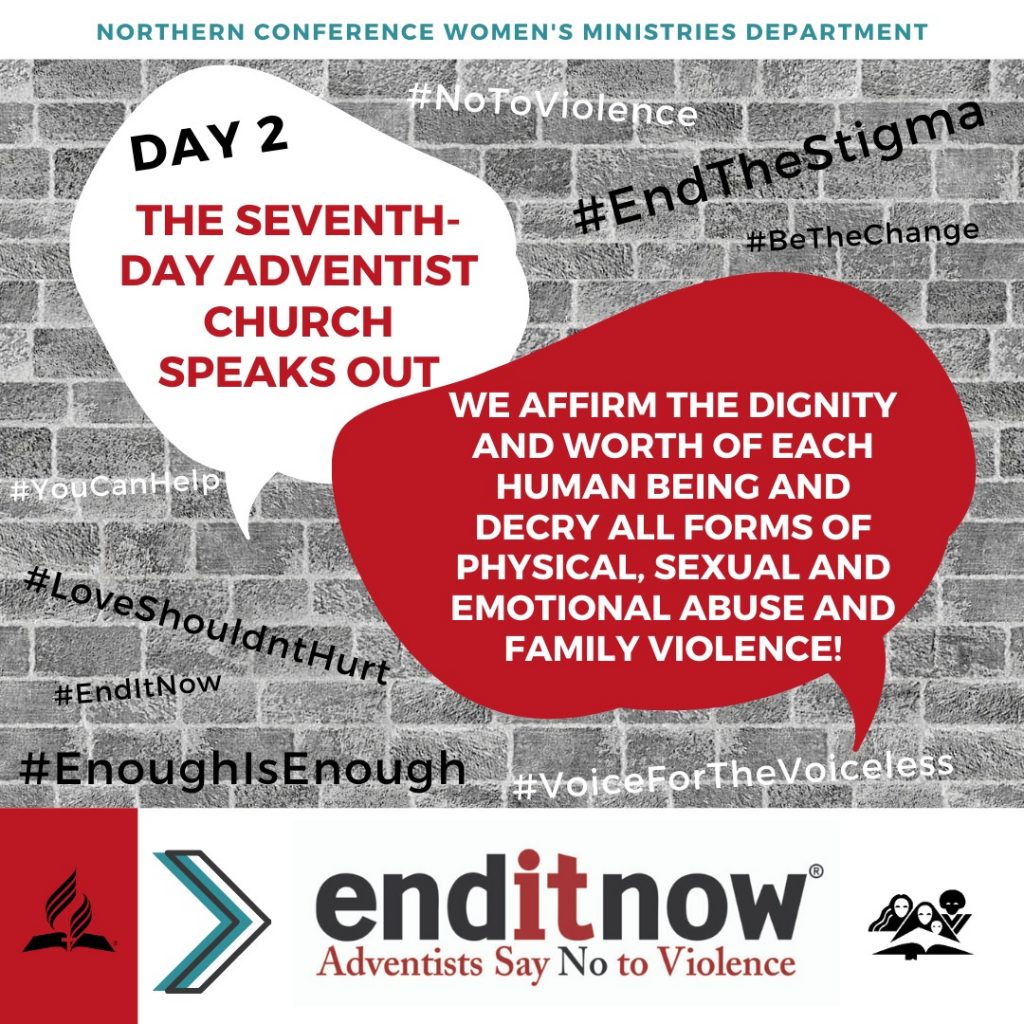
*“The Seventh-day Adventist Church Speaks Out”*
The Seventh-day Adventist Church speaks out about violence against women, children, men, and the elderly. We recognize that as believers in a heavenly Father, we must become agents of change, helping to end the evils of abuse and gender-based violence—both in society and within the church itself. The Seventh-day Adventist Church’s position is clear in the following statements:
*Statement on Abuse & Family Violence*
Seventh-day Adventists affirm the dignity and worth of each human being and decry all forms of physical, sexual and emotional abuse and family violence. We recognize the global extent of this problem and the serious, long-term effects upon the lives of all involved. We believe that Christians must respond to abuse and family violence both within the church and in the community. We believe that to remain indifferent and unresponsive is to condone, perpetuate, and potentially extend such behavior.
*Statement on Family Violence*
Family violence involves an assault of any kind—verbal, physical, emotional, sexual, or active or passive neglect—that is committed by one person or persons against another within a family, whether they are married, related, living together or apart, or divorced. The Bible clearly indicates that the distinguishing mark of Christian believers is the quality of their human relationships in the church and in the family. It is in the spirit of Christ to love and accept, to seek to affirm and build others up, rather than to abuse or tear one another down.
*Statement on Child Sexual Abuse*
Child sexual abuse occurs when a person older or stronger than the child uses his or her power, authority, or position of trust to involve a child in sexual behavior or activity. The Bible condemns child sexual abuse in the strongest possible terms. It sees any attempt to confuse, blur, or denigrate personal, generational, or gender boundaries through sexually abusive behavior as an act of betrayal and a gross violation of personhood.
Link to full Statement: https://women.adventist.org/church-statements-against-violence
For more info on the kinds of abuse and what the Bible has to say, please visit our Facebook page: https://web.facebook.com/womensministriesncsa
Day 3 – Wednesday, 27 November
The Abuser
1. Quick Involvement
An abusive individual sometimes seeks commitment from a partner within a few weeks or days of meeting. He comes on strong and gives the impression that she is the only one who can help him, that he needs her, that without her he is nothing. Because of her need to be needed and her desire to take care of someone, she nds his overtures appealing and makes the commitment, even against her better judgment and counsel from others. She might have experienced abuse in her past and now feels valued because here is someone who seems to really love her and wants her. His intent is to get her in his grasp before she is able to really get to know him.
2. Isolation
As the relationship progresses he takes up much of her time. He tells her that he wants to spend every spare moment with her because
he can’t stop thinking about her and misses her. He convinces her
that she does not need to be with other people because his love is enough. Slowly her support network diminishes, for he is always there, dominating her time, energy, and activities. Very soon she loses contact with her relatives and friends and becomes emotionally dependent
on him. He tells her that she needs only him in her life and that other people do not understand how much she means to him. She believes him because she needs to for her own feeling of self-worth. His intent is to keep others from in uencing her against having a relationship with him.
3. Manipulation and Control
At the beginning of the relationship, the abuser shows some signs of control and possessiveness. Initially this is interpreted by her as his being “jealous” of others because he loves her so much. As the relationship deepens, she tries to make him feel secure by assuring him that he is the only man in her life. He begins to control where she goes, what she does, whom she sees, what she wears, her make-up, hairstyle, friends, etc. He sometimes gets angry if she is late for an appointment with him. He accuses her of irting, being unfaithful, or having affairs. He begins to make it dif cult for her to continue regular activities such as going to school, church, parties, etc.
4. Manipulation and Control of Others
He is charming and convinces everyone outside the family that he is a good person. He appears to be the ideal husband, father, or partner to most people. In many situations, the victim is seen as the problem in the relationship and others sympathize with him because of the “kind of woman” she is. Unsuspecting individuals are fooled by the abuser who manipulates them into believing that he is the one who has been victimized. His intent is to convince others that she is crazy so they will focus on her inadequacies rather than on his abuse.
5. Unrealistic Expectations
He wants her to take care of all of his needs. He rationalizes that if she truly loves him, she’ll be able to anticipate his needs and ful ll them. She should always be willing to do what is right for him. He makes
her feel guilty if his life does not go the way he thinks it should and blames her whenever anything goes wrong. He expects her to sacri ce everything so that his dreams can come true. He establishes rules and regulations, but changes them to suit his fancy and expects her to abide by them at all times. His intent is to demean her and make her feel incompetent, inadequate, and inef cient.
6. Moody
Victims become confused about their abuser’s moodiness. At times he is very loving and compassionate. But at other times he is hateful, vengeful, and critical. Abusers often have wildly uctuating moods, giving them a Dr. Jekyll/Mr. Hyde personality. Some people may excuse this as mental illness. While it is apparent that the abuser has an emotional problem, he is not mentally ill because he is able to control his environment and others from seeing his abusive nature. Furthermore, the victim is frequently intimidated by her fear that he will fall into a bad mood, so she tries to prevent him from getting angry. His intent is to keep her close to him by giving her what she most desires—his love and attention—when he decides she is worthy of it.
7. Blaming and Shaming
He blames her and everyone else for his problems, if he admits that he has them. If confronted with this behavior, he gets angry and retaliates and justifes his hurt feelings by lashing out at her.
8. Sexually Abusive
He will force himself on his partner and tries to get his sexual needs met at any cost. He shows little or no concern for her satisfaction and
4 The Dynamics of Domestic Violence
might even resort to raping her. He demands sex when she is tired or sick. He encourages her to look at pornography against her will to “get her in the mood.” His intent is to make her fearful and to let her know that she is his property.
9. Rigid Role Expectations
He often has negative feelings toward women. He talks harshly about them and degrades them. Women t into one role: dependent, submis- sive, compliant, while men t into another role: boss, decision-maker, dominant, and tough. His intent is to keep her stuck into one mold.
10. Low Self-Esteem
He has a poor self-image and feels intimidated if his partner is more competent or better quali ed than him at anything. He resorts to put downs, name calling, and other forms of abuse directed at her. He feels that he is not good enough; therefore, if he is able to place himself above others, this will give him more self-worth and feelings of value. His intent is to put others down so that he’ll feel better about himself.
 11. Home Life/History of Abuse
11. Home Life/History of Abuse
He has experienced violence or witnessed abusive situations as a child. He learned that he can get what he wants if he uses control tactics or violence. He may have witnessed his father abusing his mother, or he was abused by parents or siblings, relatives, etc. If he abused someone in the past and was not held accountable, it is likely that he’ll do it again. Because his behavior is not challenged, he believes that it is normal. His intent is to continue a way of life that appears normal and gives him his desired results, because he is fearful that if he changes he’ll lose power and control.
12. Cruelty and Destruction of Property
He tends to be cruel to animals and punishes them brutally or
is insensitive to their pain and suffering. This cruelty can also be demonstrated when he expects others to be capable of doing things beyond their ability. For example, he might whip a one-year-old child for wetting his diaper. He will destroy property belonging to the victim.
13. Hypersensitivity
He gets easily insulted and thinks that everyone is “out to get him.” The slightest setback is seen as a personal attack. He rants and raves about the injustice of things that have happened to him, things that are really just a part of living, such as having to work over time, getting a traffic ticket, having to repeat a task, etc. His intent is to be seen
as perfect or “having it all together” in order to hide the lack of control he has over his own life and emotions.
The Dynamics of Domestic Violence 5
 14. Intimidation
14. Intimidation
He exhibits gestures that can lead to physical violence such as hitting walls, throwing objects, name calling. A victim tells the story of how her abuser intimidated her and their children so that they would obey him. She reports that he never hit her, but found out that she was planning to leave him. One day he told her and their three children to stand in front of him. Then he took their pet dog, broke its neck, and told her that if she ever left him that’s what he would do to her and the children. She was so intimidated by his behavior that it took her years to get out of the relationship. His intent is to never lose.
15. Displaced Aggression
Consciously or unconsciously he nds fault with something that is not related to his present problems. Rather than look at his own needs and issues, he focuses on other things, such as something that happened at work. He begins to rationalize that it was not right what his boss said about him. He begins to build resentment and, rather than confront his boss, he abuses his partner. His intent is to take out his anger on those in his control, rather than risk getting punished by those he believes have control over him.
It is important to note once again that women are also abusive in about
25 percent of reported cases. Women who abuse often manifest the same behaviors as male abusers, while male victims may exhibit the characteristics of a female victim. (Anyone can be an abuser or a victim!)
Day 4 – Thursday, 28 November
The Victim
The following are characteristics of an abuse victim. Even though previous abuse and low self-esteem may be risk factors for becoming a victim, anyone can fall prey to abuse. Embarrassment, shock, or fear for children’s well-being may keep the victim in a relationship with an abuser. Studies also reveal that women who expect God to miraculously deliver them from such relationships without taking decided steps to help themselves are at high risk to remain in an abusive relationship.
1. Quick Involvement
She has probably been hurt in former relationships or does not feel she is good enough to be loved for who she is. She has low self-esteem. She finds it diffi*cult to protect herself. She feels that if a man pays her intense attention she should give in to his demands because he might be her last or only chance for an intimate relationship or marriage.
2. Isolated
She feels that she is alone and that no one understands her predicament. She tends to isolate herself from family and friends out of fear of angering her partner. She often feels uneasy around other people, especially authority figures and individuals with strong, assertive personalities. Even though she isolates herself, she is fearful of rejection and abandonment.
3. Judges Self Harshly
She perpetuates negative messages heard from her family of origin (or signi cant others) and judges herself and others harshly based on those messages without challenging whether the messages are true or accurate. Because she is often isolated from friends and/or family who could give her positive messages about her value, she has only the negative feedback from her abuser. She feels hopelessly deficient in most ways.
4. Seeks Approval, Affirmation, Recognition, and Acceptance
Because she is desperate for love, acceptance, affirmation, and approval, she’ll do anything to make people like her. Not wanting to hurt others, she remains loyal in situations and relationships even when evidence indicates that the loyalty is undeserved. She often attracts emotionally unavailable people with addictive personalities.
5. Blaming
She lives life as a victim, blaming others for her circumstances, and is attracted to controlling people who like to “take charge.” She often confuses love with pity and tends to love people she can take care of or rescue. Because of her intense desire to be needed, she interprets her abuser’s dependency on her as love.
6. Super-responsible or super-irresponsible behavior
She takes responsibility for solving others’ problems or expects others to be responsible for solving hers. This is not surprising, since her abuser tells her that what he does is her fault. She might wait for someone else to save her from her relationship, whether it is another person or God. She avoids being responsible for her own life and choices.
7. Co-dependent
She has difficulty with intimacy, security, trust, and commitment in
her relationships. Because her abuser has made her focus on his needs, wishes, and requirements, she often loses sight of who she is as an individual. Lacking clearly de ned personal limits and boundaries, she becomes enmeshed in her partner’s needs and erratic emotions.
8. Controlling
An abused individual has a strong need to be in control. An abuser keeps her focused on trivial demands such as the time of meals, thetype of clothes she wears, or the rules of the house. She hopes that if she carefully controls these things, she will not be abused. When her abuser harms her and criticizes the way she has complied with his rules, she may feel that she did not do something correctly and becomes more controlling of her surroundings. She overreacts to change, especially those things over which she has no control. It is one way to survive.
9. Dependent
She has a dependent personality that is terrified of abandonment,
so she stays in situations or relationships that are harmful to her. Her fears and dependency stop her from ending unful lling relationships and prevent her from entering into ful lling ones. Because she feels so unlovable, it is difficult or impossible for her to believe that anyone can really love her for who she is. So she does everything to please others in the hopes of being good enough to merit love from them. She has difficulty understanding and de ning a healthy relationship in which her needs are also considered and attended to.
10. Denies Feelings
She denies, minimizes, or represses her feelings as a result of her traumatic childhood or the painful relationship in which she needs herself now. She may be unaware of the impact that her inability to identify and express her feelings has had on her adult life. She has a difficult time maintaining intimate relationships. She often describes herself as feeling numb.
11. Helplessness and Hopelessness
Denial, isolation, control, shame, and unfounded guilt are legacies from her family of origin. As a result of these symptoms, she feels hopeless and helpless. She thinks of herself in defeating ways, for she has been taught that nothing she does will make a difference. She believes she cannot do anything right, and this is reinforced by her abuser. She believes that she has little or no power and control over either her own life or external events that can impact her.
 12. Impulsive
12. Impulsive
An abused woman can sometimes take a decisive position without giving serious consideration to alternative behaviors or possible consequences as a result of her actions. Because she is often not allowed to make her own decisions, there are times when she makes rapid, unwise decisions because she isn’t practiced at using her own volition. At times she becomes confused, self-loathing, and feels victimized by others.
13. Serious and Burdened
She finds it difficult to have fun, especially if she had an unhealthy childhood. Consider the fear a person would experience if they felt that they had to daily answer for their behavior, whereabouts, decisions, and behaviors. Constant criticism and disappointed hopes for a happy relationship often drain the joy from her life experience.
*Service Contact:
National Crisis Line – Counselling Service 086 132 2322*
Day 5 – Friday, 29 November
THE BATTERING OR ABUSE CYCLE*
*Phase 1: _Tension Building_*
1. During this phase, minor battering incidents occur. The victim often attempts to calm the abuser, trying to meet his every whim. The victim becomes compliant or stays out of his way. Not only does she stay in the environment, she also believes she can stop his anger.
2. The victim is not interested in reality, but wishes to stop the abuse. She denies her own anger and rationalizes the situation. She tries to control events and other people in the environment around the abuser, trying to avoid all incidents that might provoke an attack.
3. Tension may be with the family ( nances, health problems, children, etc.) or from the environment (employment or unemployment, family members, isolation, etc.). Even activities that appear to be positive, like a new baby, promotion at work, etc., cause added stress.
4. She may postpone the violence, but she can’t prevent it. If there are no outlets for frustration or ways to cope with built-up anger, tension will build to explosion by the abuser.
Phase 2: _Acute Battering Incident_*
1. In the tension-building phase, there is a point where the victim can no longer control the environment. The process ceases to respond to controls and predictability. Both abuser and victim realize the attack and release of tension, which has been building, is inevitable.
2. The abuser usually accepts the fact that his rage is out of control. He starts by being able to justify his behavior for himself and, in the actual incident, doesn’t understand what has happened.
3. This phase is usually set off by an external event or inherent state of the abuser.
4. The victim sometimes provokes a Phase 2 incident to get it over with, not because she enjoys the beating, but because the tension becomes unbearable. When this happens, they could have been together long enough to recognize some sort of cycle to the battering. The victim knows what will follow Phase 2.
5. This phase is briefer than the first and third phases and usually occurs in private. Lack of control or predictability characterizes this phase.
6. The attacks are of a serious nature. Reasoning with the abuser or silence may anger him more. He often cannot stop the attack, even when the victim is seriously injured. This is commonly the phase in which police are called and/or death occurs. This is the time for intervention!
7. After the attack, the cycle moves into Phase 3
Phase 3: _Honeymoon_*
1. The tension built up in Phase 1 and released in Phase 2 is gone. This is a period of calm that is welcomed by both victim and abuser.
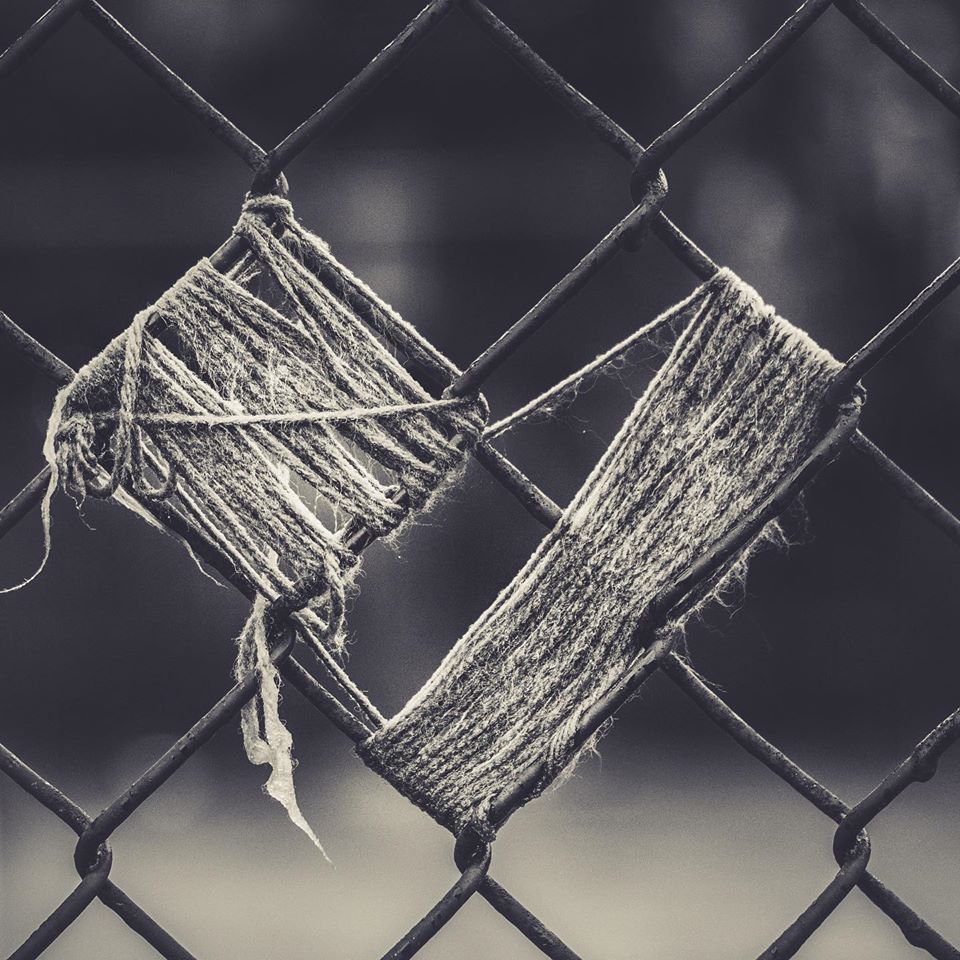 2. The abuser exhibits charming, loving, kind, and contrite behavior (Jekyll/Hyde). He believes that he will never again hurt his victim because he has taught her a lesson. He convinces everyone he is sincere. He often begs for forgiveness. He is so charming, the victim easily believes she is seeing the real or new him. The victim is most vulnerable now and has a false sense of hope because she wants to believe him. She often feels lonely.
2. The abuser exhibits charming, loving, kind, and contrite behavior (Jekyll/Hyde). He believes that he will never again hurt his victim because he has taught her a lesson. He convinces everyone he is sincere. He often begs for forgiveness. He is so charming, the victim easily believes she is seeing the real or new him. The victim is most vulnerable now and has a false sense of hope because she wants to believe him. She often feels lonely.
3. If the victim leaves: In response to her escape, the abuser intensifies his attempts to contact her. He begs for forgiveness and makes several promises. The abuser seeks help (counseling, religion), thinking it will enable him to get her back and often enlists friends, relatives, anyone (including pastors) to help him hold on to the victim. Because they believe his sincerity, they often work to get the couple back together and make the victim feel guilty for leaving. If the victim returns home too soon, the abuser ends counseling, stops going to church, etc., and the battering continues as the relationship renews itself.
4. When the victim stays through this phase, lovemaking is intense and bonds them together.
5. When this phase is complete, the couple moves back into Phase 1 and repeats the cycle.
Day 6 – Sabbath, 30 November
How Are You Condoning Domestic Violence?
Day 7 – Sunday, 1 December – World Aids Day
World Aids Day 2019 – A Special Message From Connie Penniken
Day 8 – Monday, 2 December
*Day 8 of our 16 Days of Activism Against Violence & Abuse Perpetrated Against Women and Children.*
USE THIS DECISION TREE TO GUIDE YOU THROUGH THE INITIAL PROCESS.
_With each “NO” resolve the situation, then return to the last “YES” to proceed._
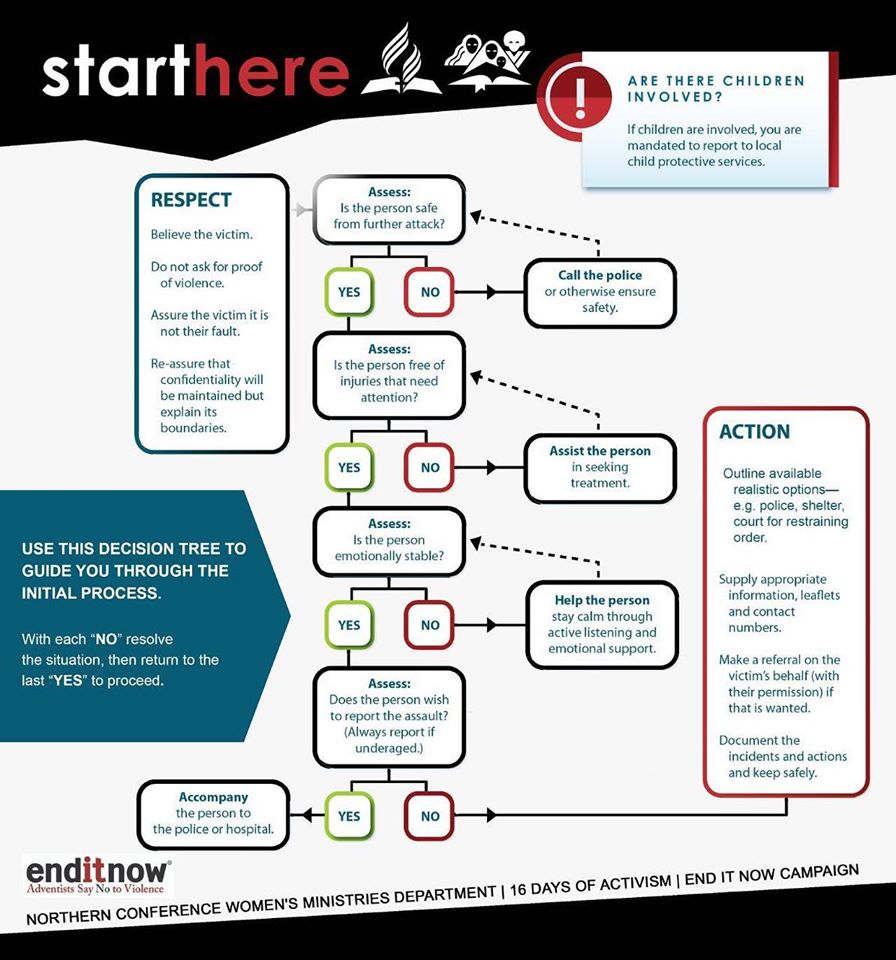
For more information and the full article an how to help someone report domestic violence kindly follow the link below: https://www.saps.gov.za/…/women_child…/domestic_violence.phpPlease share these resources with your friends.
*You can make a difference!*
Helplines: SAPS Crime Stop
Tel: 08600 10111
Family and Marriage Society of South Africa (FAMSA)
Tel: (011) 975 7107
National Crisis Line
Tel: 086 132 2322
Day 9 – Tuesday, 3 December
*Day 9 of our 16 Days of Activism Against Violence & Abuse Perpetrated Against Women and Children.*
WAYS THAT YOU CAN HELP
*H* ealth & Safety
*E* motional
*L* egal
*P* sychological
For more information and contact numbers kindly follow the link below: https://www.gov.za/…/where-can-i-find-organisation-offers-a…
Please share these resources with your friends.
*You can make a difference!*
Gender -Based Violence Command Centre
Tel: 0800 428 428
Stop Gender Violence Helpline
Tel: 0800 150 150 / sms * *120**7867 # from any cell phone
Childline
Tel: 08000 55 555
SA National Council for Child Welfare
Tel: 011 339 5741
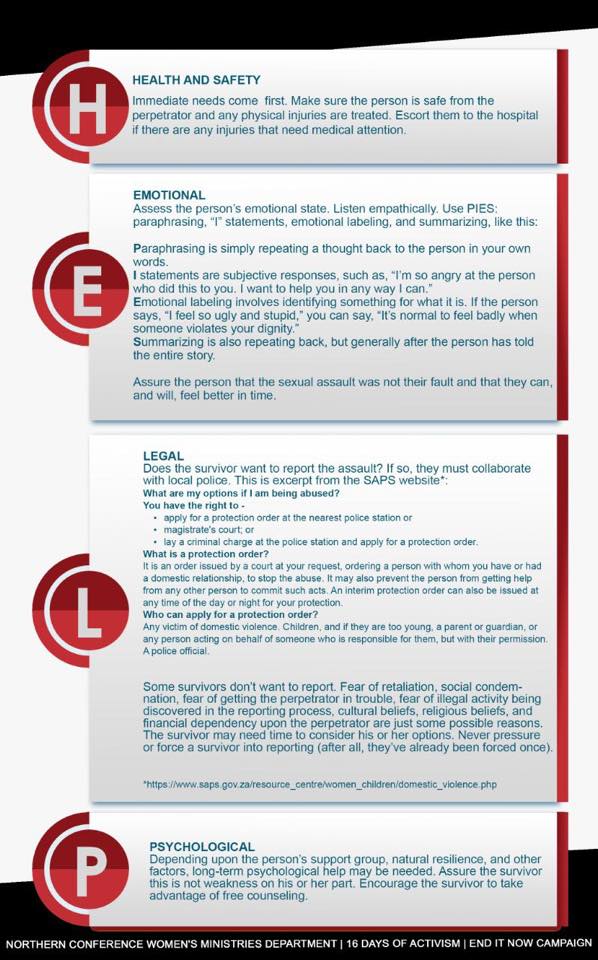
Day 10 – Wednesday, 4 December
Day 10 of our 16 Days of Activism Against Violence & Abuse Perpetrated Against Women and Children.
Shelter List for victims: Part 1
EKHAYA OVERNIGHT SHELTER
C/O SMIT & CLAIM STREETS-HILLBROW | 011 725 6531
MEN & WOMEN (NO CHILDREN) R5 PER NIGHT
PLACE OF REFUGEE
DIAGONAL STREET LA ROCHELLE | 011 435 7867
MEN AND WOMEN (FREE)
STRABANE MERCY CENTRE
98 KERK STREET-JHB | 011 336 2423
MEN & WOMEN (30 YEARS+ABOVE) R5 PER DAY
IMMACULATA MERCY CENTRE
17 STURDEE AVENUE-ROSEBANK | 011 447 4399
SINGLE MEN ONLY R5 PER NIGHT
USINDISO SANCTUARY
80 ALBERT STREET-JHB | 011 334 1143
WOMEN WITH CHILDREN
FREDA HARTLEY SHELTER FOR WOMEN
97 REGENT STREET-YEOVILLE | 011 648 6005
WOMEN ONLY (FREE)
Day 11 – Thursday, 5 December
*Day 11 of our 16 Days of Activism Against Violence & Abuse Perpetrated Against Women and Children.*
Shelter List for victims: Part 2
*BIENVENU SHELTER*
36 TERRACE ROAD-BETRAMS | 011 624 2915
_REFUGEE WOMEN AND CHILDREN FOR 3 MONTHS ONLY_
*NISSA*
19 LINK STREET-LENASIA EXT. 1 | 011 854 5804 or 011 231 5050
_ABUSED WOMEN AND CHILDREN_
*POWA*
64 MITCHELL STREET-BEREA | 011 642 4345
_ABUSED WOMEN_
*IKHAYALETHEMBA*
176 SMIT STREET-BRAAMFONTEIN | 011 242 3000
_ABUSED WOMEN_
*BETHANY*
C/O MILLBOURN ROAD & VILJOEN STREET | 011 614 3245
_ABUSED WOMEN_
*THE HOUSE*
60 OLIVIA ROAD-BEREA | 074 587 7057
_GIRLS BETWEEN 12 AND 18 YEARS OLD_
*JABULANI KHAKHIBOS KIDS CENTRE*
1 HIGH STREET-BEREA | 084 620 1465
_BOYS WHO HAVE BEEN ON THE STREET_
Day 12 – Friday, 6 December
Day 12 of our 16 Days of Activism Against Violence & Abuse Perpetrated Against Women and Children.
“Spiritual abuse can be hard to identify but it is no less difficult to endure than any other kind of abuse.”
Spiritual Abuse: The Definition
- Spiritual abuse, intended or unintended, occurs when a person in a position of power uses that power to manipulate or control the thoughts and/or actions of those under their leadership.
- This is often done by creating a toxic culture within the church or group by shaming or controlling members using the power of their position and neutralizing or eliminating dissent.
Spiritual Abuse: The Perpetrators
Potential Spiritual Abusers can include:
- Church Officials at all Levels of Leadership
- Pastors
- Elders
- Deacons and Deaconesses
- Sabbath School Teachers
- Church Members who see it as their duty to make everyone live up to the Standards of the Church
- Parents or other Caregivers
Spiritual Abuse: The Perpetrators
The profile of Spiritual Abusers often includes:
- Personal Insecurity
- A Tendency toward Perfectionism
- Performance Orientation
- A Need for Power and Control
- A Need to Look Good or Competent in the Eyes of Others
- A Life Dominated by Fear rather than by Love
Spiritual Abuse: The Vulnerable
Children Who:
- Have parents who control their every thought and action.
- Have not been taught to think for themselves, but who parrot their parents’ words, thoughts and actions.
- Have been raised with an unhealthy fear of an angry, vindictive, or arbitrary God
- Children who have received confusing messages about God through conflicting words and actions from their parents or church leaders
Spiritual Abuse: The Vulnerable
Adults Who:
- Have never fully differentiated from their parents (put away childish things) 1 Corinthians 13:11
- Do not have a solid sense of themselves but are overly dependent on the thoughts and approval of others
- Live by fear and shame
- Have not experienced the love of God for themselves (Ephesians 3:16-19)
- Have difficulty trusting enough or too much
Spiritual Abuse: Other Examples
- Slave Masters misused the Scripture “Bondservants, be obedient to those who are your masters according to the flesh with fear and trembling as to Christ” Ephesians 6:5 and thus misrepresented God.
- Abusive husbands use “Wives, submit to your own husbands, as to the Lord” to control their spouses.
Signs of spiritual abuse between intimate partners include when an abusive partner:
- ridicules or insults the other person’s religious or spiritual beliefs
- prevents the other partner from practicing their religious or spiritual beliefs
- uses their partner’s religious or spiritual beliefs to manipulate or shame them
- forces the children to be raised in a faith that the other partner has not agreed to
- uses religious texts or beliefs to minimize or rationalize abusive behaviors (such as physical, financial, emotional or sexual abuse/marital rape)
Discounting a Victim’s Experience
- In addition to whatever other intimate partner violence that has occurred, victims experience additional spiritual abuse when:
- It is not safe for them to speak to church leadership due to patriarchal norms.
- The victim’s experience is discounted when they share it by statements such as “He is not that kind of person” or “I could never imagine him doing such a thing. He’s such a nice man.”
- The victim is marginalized or removed from office.• The victim is disfellowshipped for being “a liar.”
Day 13 – Sabbath, 7 December
*Day 13 of our 16 Days of Activism Against Violence & Abuse Perpetrated Against Women and Children.*
We live in an increasingly complicated world, Paul told Timothy that “In the last days, we will have dangerous times” (2 Tim. 3:1). Those times are here. Pray that you will be granted an abundance of humility, teach-ability, and spiritual discernment in order to be able to identify danger and have the courage to do the right thing.
Day 14 – Sunday, 8 December
*Day 14 of our 16 Days of Activism Against Violence & Abuse Perpetrated Against Women and Children.* – A Special Radio Interview with Ms Gail Masondo, Ms Penny Lebyane & Ms Thembi Masondo.
Day 15 – Monday, 9 December
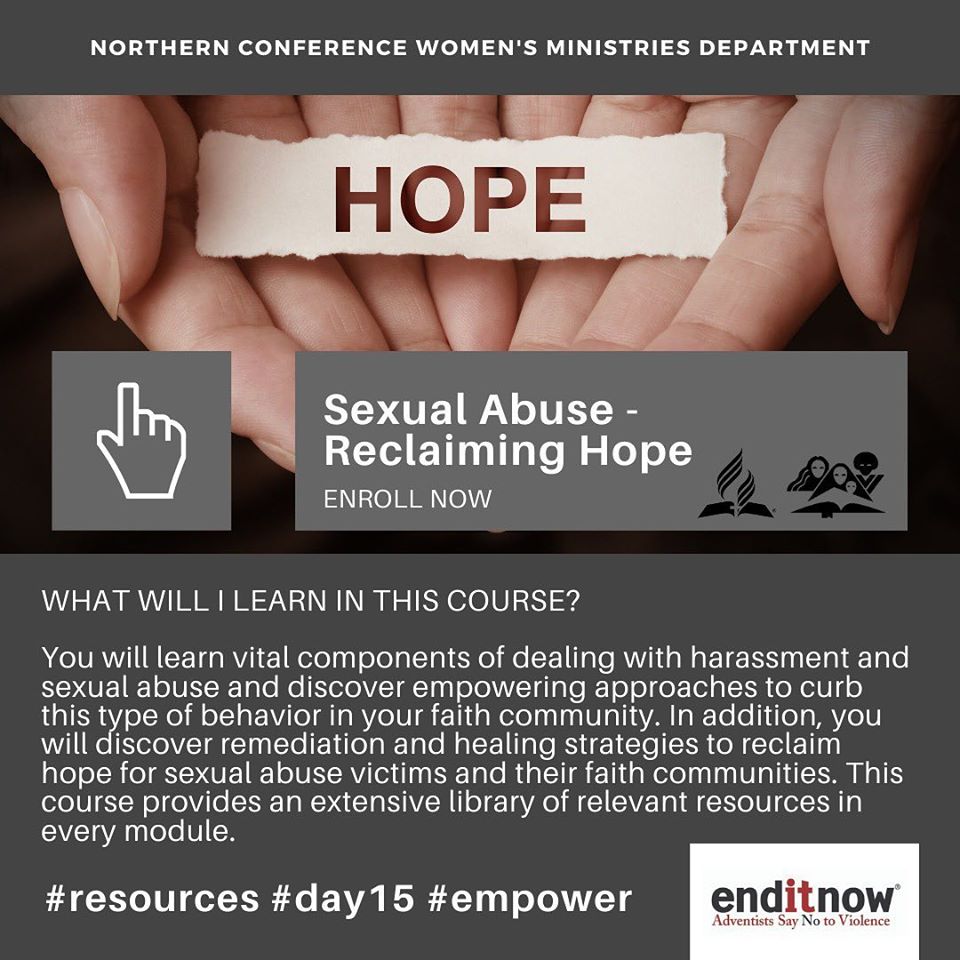
*Day 15 of our 16 Days of Activism Against Violence & Abuse Perpetrated Against Women and Children.*
*Sexual Abuse – Reclaiming Hope* | Online Course by Adventist Learning Community
*Course Summary*
The purpose of the 6-module course is to explore multiple aspects of sexual abuse including awareness, prevention, recognition, protection, investigation, advocacy, responsibilities, organizational supports, healing, and structural approaches to stem the tide of unfortunate and criminal activities within the Seventh-day Adventist faith community. Unfortunately, abuse, harassment, and misconduct happen. Much of this takes place with our most vulnerable faith community members, our children, and young adults. As a church organization, we are taking a stand to stop sexual abuse. There are many things that can be done to limit or stop these types of incidents in your faith community. But the first step is talking about it.
To Register please click on the link: https://www.adventistlearningcommunity.com/…/sexual-abuse-r…
Day 16 – Tuesday, 10 December
The final day of our campaign
